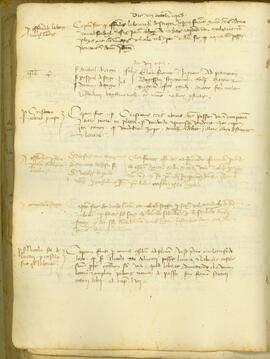The fonds contains volumes of documents on the rent collection for state-owned buildings primarily in the northern area of Dubrovnik, as well as documents regarding the rent collection for the buildings located on the main city street called Placa. Preserved documents show data until the earthquake in 1667 thus allowing researchers to monitor renting of land and buildings owned by state. According to the existing data, the reconstruction of Dubrovnik after the earthquake began precisely with the reconstruction of state-owned buildings. At the same time, the city authorities tried to restore the system of rent collection. However, financial difficulties forced them to sell most renovated houses and, in this way, raise funds for the renovation of the main buildings of the most important secular and ecclesiastical institutions in the city. The data also show that only a few buildings on the street Placa and in the northern part of the city of Dubrovnik were state-owned after 1667.
This fonds is very important for the research of the history of the ghetto in Dubrovnik, and it also provides data on buildings outside the ghetto in which the Jewish population lived, as well as on the business premises they would lease. The ghetto of the Dubrovnik Republic was in the northern part of the city, and it was established in 1546, in the Street Lojarska. The data in the fonds allow researchers to reconstruct precisely which buildings were a part of the city ghetto and it also further indicates how, with time passing, this ghetto gradually increased or decreased in size. The Jewish community paid the rent for all the buildings that belonged to the ghetto so the precise information on actual persons who lived in those buildings was never recorded. However, the recorded data provide the names of Jews who lived outside the ghetto, specifying as well as the buildings in which they lived, or the premises in which they worked, as well as the amount of the rent they paid (e.g., vol. 14, f. 105). The data thus clearly show that Jews originally lived and did business only in the buildings or premises near the ghetto. This changed in the 18th century, when the records indicate that more Jews lived or worked in the area that encompassed the streets from the ghetto towards the street Antuninska, and there are also references to some Jews who lived in the street of Prijeko. Since a large part of the city was destroyed in the earthquake of 1667, when many buildings on Placa Street collapsed, the authorities allowed businessmen to build improvised wooden shops on the main street, several of which were evidently run by Jews.

